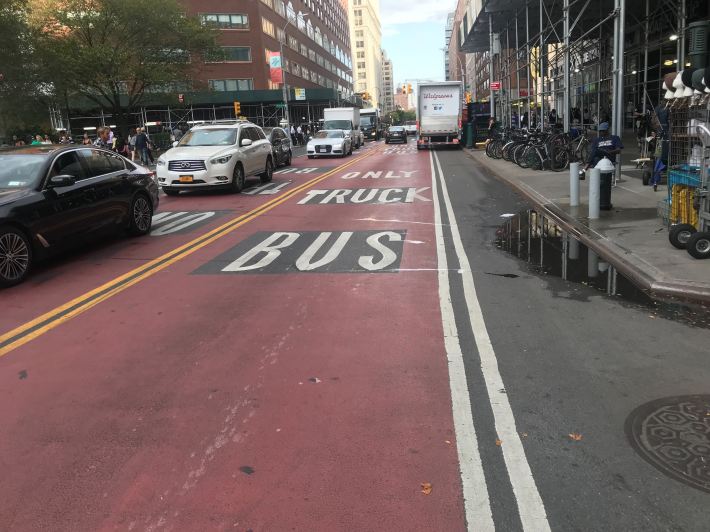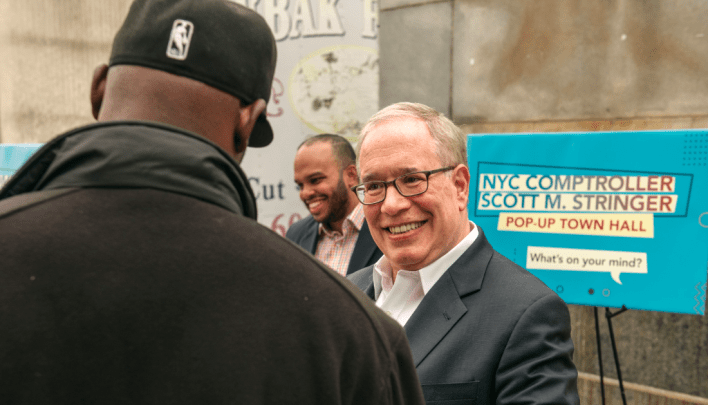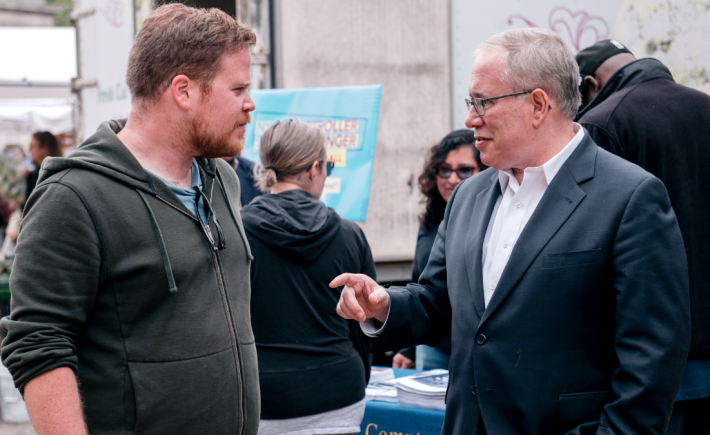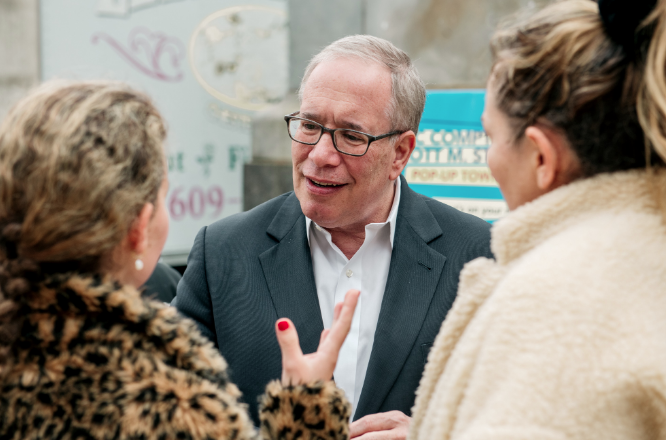Jesse Singer, editor of Transportation Alternatives’s Reclaim Magazine, recently sat down with Comptroller Scott Stringer, New York City’s chief fiscal officer and a candidate for the mayoralty. They talked about his solid plan for the crumbling Brooklyn-Queens Expressway, busways, bike lanes, placards, and all things transportation. Adapted from the new issue of Reclaim, the in-house magazine of Transportation Alternatives (which all TransAlt members get for free at transalt.org/membership).
This issue of Reclaim is about the peril and potential of the city’s aging highways. Looking at the BQE as an example, can you talk us through your plan?
The history of this is that the city basically had a “Robert Moses” concept of what a new BQE would look like — the new BQE would be the same as the old BQE. But if we’re really going to think about changing the car culture, breaking the car culture, the agenda should not be about adding lanes but reducing lanes, adding park space, and transportation alternatives.
That is basically the concept that we came to the BQE with. We wanted to make the repairs faster and more efficient, so we isolated the repairs to the third cantilever — a truck-only throughway. And we wanted a new park running through all the neighborhoods, and that really to me is the best part.
We want real transportation alternatives, we want an environmentally-friendly city, but in order to get there, we’re going to have to do things that we really haven’t been asked to do in the modern city.
The question — not just for the BQE but for other super-highways around the city and around the country — is how do we go about ending car culture, first by reducing lanes and then by fundamentally changing the transportation infrastructure in the city?
The number of car registrations is up, and so is the size and miles-traveled of the city’s fleet. City officials are handing out more parking placards than ever. How do we change the car culture?
If it were up to me, we would just slash the [number of ] placards in half, review every single placard, and every time you did away with a placard, you removed a car from the street.
While there are obviously essential needs for cars in city government, not everybody with an excuse should have a car and a placard. It’s an outdated way of serving the city. The way you invest in the city is by getting more people to use public transportation and city workers should be first and foremost in that line.
That is also true of rising car registrations. We need to build a transportation infrastructure where people can go from the car to another form of transportation, whether that’s bike lanes or a working subway system.
Realigning the bus system, for example, is one of my priorities because if you’re going to ask people to give up their cars, you’ve got to give them a transportation mode that works. We have failed to align our buses to the new economy, so our buses run as if it were the 1950s or 1960s, when rush hour was defined as 7 a.m. to 9 a.m. and 5 p.m. to 7 p.m. because everyone had to be home with the family for dinner.
Back then, people from the various boroughs would come into the city, many by bus, and go to work in Midtown Manhattan. They called it the central business district — there’s a reason we don’t do that anymore. Everything has changed.
I can tell you, as comptroller, when you crunch the numbers, 83 percent of the new jobs in the city are in Brooklyn and Queens. People are working more within their borough than ever before. People in Queens work in Queens, people in Brooklyn work in Brooklyn, in fact, Brooklyn now works in Queens and vice versa. Yet the buses aren’t aligned for that.
It is an equity issue. The poorest people in the city ride the bus, people who make the least amount of money, but work the hardest, longest hours. Some of the struggling New Yorkers who are living in the outskirts of the city don’t get home until 11 or 12 o’clock, and yet the buses stop running and the trains barely run at night. So, who are we servicing?
Buses matter, and if you can realign the bus system, build out the bus transit system, build those protected bike lanes, reinvest in the subway system, you’d have to be crazy to take a car. That should be the way we think.
Bus ridership is down since Uber and Lyft brought in for-hire vehicles. What steps would you take to turn that around?
We need dedicated bus lanes, and we need elected officials to get on board what it means for dedicated bus lanes.
Look at 14th Street. People said to me, “Why are you the only citywide elected official that came out in support?” It is because I’m not putting my finger in the air, looking which way the wind is blowing, saying that I kind of like it but I don’t want to commit to it — that’s political speak.
My view was you have a plan, put it out there, implement it. It’s going to work, but let’s see. That should be the kind of planning we do: come up with an idea, and implement it. Don’t worry about the political consequences. Stop baby-stepping. Stop supporting incremental transportation change. Stop kicking the can down the road — saying by the year 2040, we will have a great sustainable city. It’s not true.
We have to measure how we build out our transportation network, not in decades, but in years. That is how government should be working.
The 14th Street busway also brought lawsuits, and outrage at the community board level. What is driving that?
I don’t really share that view that there’s outrage. Part of what city government and community-based organizations have to do is work with local communities and community boards. I say this as somebody who served as Manhattan Borough President for eight years. I’m used to community engagement. I believe community boards are actually a resource.

Yes, when I do town hall meetings and I talk about these issues, some people get angry, some people boo, but at the end of the day, you need to use that time as a dialogue with the community.
Success will be turning down the volume, listening to the legitimate concerns of people who look at bikes on the sidewalks or bikes coming at them, people who are older who say, “I’m afraid of that, because if I fall, that could shorten my life.” That’s not something we should trivialize.
We should get in a room and figure out how we make everybody safe. One way is by investing in pedestrians, and by doing that, you then invest in protected bike lanes and you change the culture of the city from a planning perspective.
Instead of doing the Robert Moses car-first proposal, you build out pedestrian right of way, bike lanes, and bus lanes, and you start to transform the city. The best way to do this is through the lens of an entire view of what our city should be like going forward — how we build out affordable housing and economic development and tie it in to transportation.
We are so far behind, it’s kind of amazing that the great urban experiment called New York City is taking a backseat to some of these major international cities. We should just take the conversation and lead, and build a constituency for change in this city.
You can’t bend the car culture. You’ve got to break the car culture — and you’ve got to do it now. The only way to do that is to build out transportation alternatives. Some people need cars, but they want alternatives, especially in the far regions of the cities. Let’s give it to them.
Cyclist fatalities are way up this year. What is causing the rise and what will stop it?
We need a little more vision in Vision Zero. It sounds good, but it is not what it should be. It’s pretty clear to me that you have got to protect bike riders, and that takes resources, it takes planning and purpose — but you have to move faster.
There’s a conflict with what we’re doing now. We are rapidly building out Citi Bike — a different infrastructure for transportation — but we’re missing one key component, which is, how do we safely build this out? That can’t wait two years. You can’t put people in harm’s way.
It’s pretty clear that we have not built out the safety infrastructure — not for cyclists, not for pedestrians, and especially not for children.

As a father of a seven-and-half-year-old and a six-year-old, I’ll tell you what I worry about every day. I worry about them in the morning, going to school, and I worry about them coming home. I don’t feel comfortable until I know they’re home every day.
I worry about the trucks. I worry about the cars that come right up to the baby carriage. Then you look at the driver mumbling to himself, “This is outrageous. There’s a baby carriage in the middle of my way.”
That is the car culture we have to break. Who gets the priority? I side with the kids and the parents who are trying to navigate the streets getting to school. Just like we hold the yellow bus sacrosanct, right when that stop sign comes out, we should be equally outraged about the speeding cars and callous driving right past schools.
Instead of waiting for people to die, which is what we do now.
We have to go from being reactive to proactive. We have to stop thinking about the big decisions that we might make 20 or 30 years from now, and start now. That’s why I created that BQE study and those recommendations, not because the Comptroller’s Office has all the answers — we don’t.
There are very good plans for the BQE, but the one thing that we challenged was the culture of planning in the city. We didn’t accept the default of building a highway with more lanes to reduce car traffic. The more lanes of traffic you have, the more cars you will have. When you take away lanes of highway, you reduce traffic.
Now that we know this, let’s start a planning process throughout our five boroughs, because this is not the only highway that’s going to need repairs.
We know what’s coming in the next decade. The modeling, land use, and zoning work that we do today can be a model for restructuring the transportation network in the city. We have to build out our transportation alternatives, and really invest in them.
Speaking of planning, the city is in an affordability crisis. Is there an answer to those problems in our streets?
The first question we should ask is from a transportation perspective: Who do we want to build transportation for?
I would argue that there’s a number of answers. You want to build out pedestrian- and community-friendly neighborhoods so that people can safely raise their children. You need to do everything you can to protect seniors who have to navigate complicated and very dangerous streets. There’s a lot of planning that goes into that.

While we’re doing that, we also have to build the next generation of affordable housing. We have a record number of homeless people both in the streets and in our shelters, so we need a new housing plan that is going to create housing for the poorest people in the city.
Then we have to think about how we create that affordability, and also the transportation network that could get people to work, and back to their families, in a timely fashion.
You can’t silo transportation, housing, or education. It’s all very connected — how we get kids to school in the morning, how we get them back to their families, how we build the next generation of housing to keep people here, and also for new people to come here.
We need to make sure that immigrants can continue to come here. The entrance fee to the city can’t just be a $2 million condo. We have to give people more housing options as well as transportation options.
You see people being pushed, mostly people of color, to the outskirts of the city, where they are barely hanging on. That’s not where the jobs are being created, and that’s not where the transportation alternatives are being built. We’re going to have to rethink, and reimagine how government can move faster.
What will transportation in New York City look like in 10 years?
The real question is what do we want our city to be, and how can we create more equity in the city, more fairness. Transportation should not be defined based on the wealth you have: wealthy people get to have cars; poor people have to rely on a broken-down transportation system.
We have to come to terms with what is fair, and once we do that, we have to realign our agencies to move at a rapid pace. We are falling behind some of the great international cities.
I can tell you, as comptroller, that’s not good for business. There is a competition around the world for the city with the most environmentally-friendly options. We want to lead the conversation. Why should we have to take a backseat to Seoul, Bogotá and Paris?
We need to have an urgency to our planning and we have to be specific, neighborhood by neighborhood, about how to get there. Ten years from now we should not be having the same conversation about the slow pace of change. We should take chances with big ideas and we should try to do big things.
The busway on 14th Street was a big idea. There are a lot of those kinds of ideas that should be implemented right now to build the ultimate sustainable city.
If New York does this, then we will fundamentally change the planet. Let’s get the bureaucrats out of the way. Let’s go back to communities. Let’s build partnerships with community-based organizations, bring the best and brightest into city government, and launch the next big idea that will be the hallmark of New York.
City & State NY is hosting a full day New York in Transit summit on Jan. 30 at the Museum of Jewish Heritage. This summit will bring together experts to assess the current state of New York’s transportation systems, break down recent legislative actions, and look towards the future of all things coming and going in New York. Join Keynote Speaker Polly Trottenberg, commissioner of the NYC Department of Transportation, along with agency leaders, elected officials, and advocates. Use the code STREETSBLOG for a 25-percent discount when you RSVP here!







